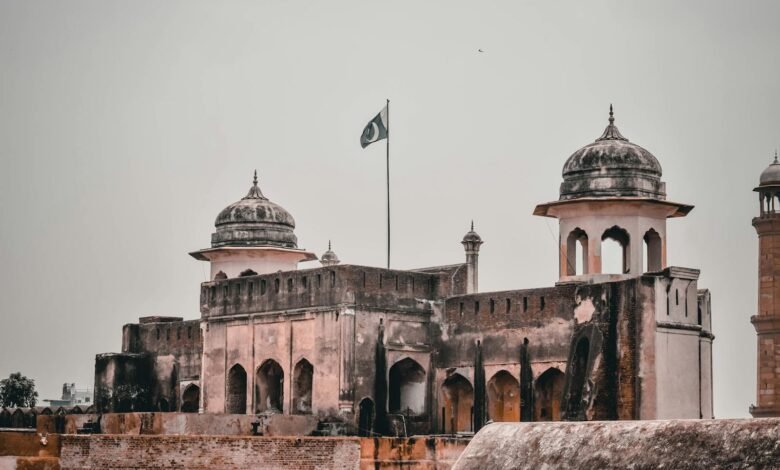Forts in Pakistan: A Glimpse into History

Pakistan is home to some of the most iconic and historically significant forts that offer a window into its rich past. From ancient empires to Mughal dynasties, these forts have witnessed the rise and fall of rulers and have become integral to the country’s heritage. For tourists, visiting these forts provides not only an insight into Pakistan’s history but also a chance to explore the architectural brilliance of bygone eras. Here’s a look at some of the most famous forts in Pakistan.
1. Lahore Fort (Shahi Qila)
Location: Lahore, Punjab
Historical Significance: A UNESCO World Heritage site, the Lahore Fort is an impressive Mughal-era fort built in the 11th century, though most of its present structure dates back to the reign of Emperor Akbar in the 16th century. The fort is a stunning example of Mughal architecture, featuring grand palaces, halls, and gardens. Key attractions within the fort include the Sheesh Mahal (Palace of Mirrors), Naulakha Pavilion, and Alamgiri Gate. The fort’s strategic location next to the Badshahi Mosque makes it a must-visit for tourists.
Tips for Tourists:
Visitors can explore the fort’s museum, which displays artifacts from the Mughal period. A guided tour is recommended to fully appreciate its history.
2. Rohtas Fort
Location: Jhelum, Punjab
Historical Significance: Another UNESCO World Heritage site, Rohtas Fort is a formidable structure built by the Afghan ruler Sher Shah Suri in the 16th century. The fort was constructed to prevent the return of Mughal Emperor Humayun and to suppress local Gakhar tribes. Rohtas Fort is known for its massive walls and defensive architecture. With 12 gates, the fort spreads over 70 hectares, making it one of the largest forts in Pakistan.
Tips for Tourists:
Wear comfortable shoes for walking, as the fort is quite large. The Sohail Gate is one of the most impressive gates and a perfect spot for photography.
3. Derawar Fort
Location: Cholistan Desert, Bahawalpur, Punjab
Historical Significance: Rising out of the barren Cholistan Desert, Derawar Fort is a stunning sight with its towering 40 bastions. The fort was initially built by the Bhatti Rajput rulers and later taken over by the Nawabs of Bahawalpur in the 18th century. Derawar Fort’s massive square structure is visible for miles around and is a testament to the strategic importance it once held. While the interior of the fort is not as well-preserved as other forts, its imposing outer walls make it a must-see for history lovers.
Tips for Tourists:
The fort is located in a remote area, so it is advisable to visit with a local guide. The Cholistan Desert Jeep Rally takes place nearby, making it a great time to visit.
4. Ranikot Fort
Location: Jamshoro, Sindh
Historical Significance: Often called the “Great Wall of Sindh,” Ranikot Fort is one of the largest forts in the world, with a circumference of approximately 32 kilometers. Though its origins remain unclear, it is believed to have been built during the Sassanian or possibly the Talpur dynasty in the early 19th century. The fort’s walls snake over rolling hills, offering a dramatic view of the surrounding landscape.
Tips for Tourists:
The fort is relatively remote, so plan for a day trip from Karachi. The trek around the walls is quite extensive, so carry water and wear comfortable walking shoes.
5. Altit and Baltit Forts
Location: Hunza, Gilgit-Baltistan
Historical Significance: Altit and Baltit forts are two ancient forts situated in the scenic Hunza Valley. Baltit Fort, with its Tibetan-style architecture, served as the residence of the rulers of Hunza for over 700 years. It has been restored and now serves as a museum. Altit Fort, on the other hand, is even older, dating back over 900 years. These forts provide a glimpse into the history and culture of the people of Hunza and their strategic importance in the Karakoram region.
Tips for Tourists:
Both forts offer breathtaking views of the Hunza Valley, making them popular spots for photography. Guided tours are available to understand the historical significance of the forts.
6. Kot Diji Fort
Location: Khairpur, Sindh
Historical Significance: Built by the Talpur dynasty in the early 19th century, Kot Diji Fort is perched on a hill overlooking the Indus Valley. The fort’s strategic location made it a key defense point in the region. It is constructed with large stone blocks and features impressive bastions and watchtowers. Though not as large as some other forts in Pakistan, Kot Diji is notable for its well-preserved structure and scenic views.
Tips for Tourists:
The fort is located close to the Kot Diji archaeological site, which predates the Indus Valley Civilization, making it an interesting place for history enthusiasts.
7. Skardu Fort (Kharpocho Fort)
Location: Skardu, Gilgit-Baltistan
Historical Significance: Situated on a hill overlooking the town of Skardu, Kharpocho Fort was built by the rulers of Baltistan in the 16th century. The fort provides panoramic views of the Skardu Valley, the Indus River, and the surrounding mountains. While much of the fort is in ruins, it holds great historical importance as a symbol of the region’s independence and resilience.
Tips for Tourists:
The hike to the fort can be steep, but the views are worth it. Early morning visits provide the best light for photography.
Conclusion
The forts of Pakistan are a testament to the country’s rich history, showcasing a blend of architectural styles from different periods and rulers. From the Mughal splendor of Lahore Fort to the desert majesty of Derawar Fort, each fort tells a unique story. For tourists, these forts offer an exciting journey through time, coupled with breathtaking views and cultural insights.



